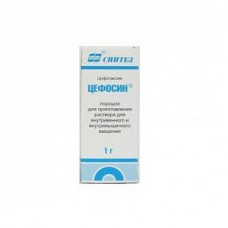Expiration date: 09/2026
Composition and form of issue:
Powder for preparation of solution for intravenous and intramuscular administration 1 flask contains:
Cefotaxime sodium salt 0.5g, 1g or 2g
in a pack of cardboard 1 bottle or a box of 50 bottles.
Powder for preparation of injection solution for intramuscular injection 1 flask contains:
Cefotaxime sodium salt 0.5g, 1g or 2 g.
in a pack of cardboard 1 bottle or a box of 50 bottles.
Characteristic:
Cephalosporin antibiotic of III generation for parenteral administration.
Pharmacological action:
Violates the synthesis of cell walls of microorganisms.
Pharmacokinetics:
After a single in/in doses of 0, 5, 1 and 2 g Cmax achieved through 5 minutes and is 39 ug/ml, 100 ug/ml and 214 ug / ml, respectively. After I/m administration in doses of 0, 5 and 1 g Cmax achieved through 0, 5 h and is 11 and 21 mg / ml, respectively. Communication with plasma proteins-25-40%. Creates therapeutic concentrations in most tissues (myocardium, bones, gall bladder, skin, soft tissues), liquids and secrets (synovial, pericardial, pleural, sputum, bile, urine, cerebrospinal fluid) of the body. T1/2 — 1 h at in/in the introduction and 1-1. 5 h, with the/m introduction. Excreted by the kidneys-60-70% unchanged, the rest — in the form of metabolites (deacetylated derivative has bactericidal activity, other metabolites do not possess). In chronic renal failure and in elderly people T1 / 2 increases by 2 times. T1/2 in neonates — 0, 75-1, 5 hours, premature infants increases to 6, 4 h. With repeated on/in the introduction in a dose of 1 g every 6 h for 14 days cumulation is not observed.
Description of the pharmacological action:
Active against gram-positive and gram-negative microorganisms resistant to other antibiotics: Staphylococcus spp. (including Staphylococcus aureus, including penicillinase-producing strains), Staphylococcus epidermidis, Streptococcus pneumoniae, Streptococcus pyogenes, Streptococcus agalactiae, Enterococcus species, Enterobacter spp., Escherichia coli, Haemophilus influenzae (including strains producing penicillinase), Haemophilus parainfluenzae, Klebsiella spp. (including Klebsiella pneumoniae), Morganella morganii, Neisseria gonorrhoeae (including strains forming penicillinase), Neisseria meningitidis, Escherichia coli, citrus spp., Proteus mirabilis, indole Proteus, Proteus vulgaris, Providencia spp. (including Providencia rettgeri), and Serratia spp., Pseudomonas aeruginosa (individual strains), Acinetobacter species, Corynebacterium diphtheriae, Erysipelothrix insidiosa, Bacteroides spp. (including some strains of Bacteroides fragilis), Fusobacterium spp. (including Fusobacterium nucleatum), Peptococcus spp., Peptostreptococcus spp., Eubacterium spp., Propionibacterium spp., Bacillus subtilis, Clostridium spp. (including Clostridium perfringens).
Resistant to most beta-lactamases gram-positive and gram-negative microorganisms, penicillinase staphylococci, Clostridium spp.
Indications:
Bacterial infections of severe course caused by sensitive microorganisms: infections of the Central nervous system (meningitis), respiratory tract and ENT-organs, urinary tract, bones, joints, skin and soft tissues, pelvic organs (including chlamydia, gonorrhoea), infected wounds and burns, peritonitis, sepsis, bacteremia, abdominal infections, endocarditis, Lyme disease, typhoid fever, infections on the background of immunodeficiency, prevention of infections after surgery operations (including urological, obstetrical and gynecological, on ZHKT).
Contraindications:
Hypersensitivity (W. to penicillins, others cephalosporins, carbapenems), children up to age 2, 5 years (for the/m introduction).
Application for pregnancy and breastfeeding:
In pregnancy, it is possible if the expected effect of therapy exceeds the potential risk to the fetus. At the time of treatment should stop breastfeeding (Cefotaxime penetrates into breast milk).
Side effect:
Allergic reactions: urticaria, chills or fever, rash, itching, rarely bronchospasm, eosinophilia, Stevens — Johnson syndrome, toxic epidermal necrolysis, angioedema, anaphylactic shock.
From the digestive tract: nausea, vomiting, diarrhea or constipation, flatulence, abdominal pain, dysbiosis, impaired liver function (increased activity of hepatic transaminases, alkaline phosphatase, hypercreatininemia, hyperbilirubinemia), rarely — stomatitis, glossitis, pseudomembranous enterocolitis.
From the cardiovascular system and blood (hematopoiesis, hemostasis): leiko-, Neutro-, granulocyte - or thrombocytopenia, hemolytic anemia, hypocoagulation.
On the part of the genitourinary system: renal dysfunction (azotemia, increased urea in the blood, oligo - or anuria.
From the nervous system and sensory organs: headache, dizziness.
Other: local reactions-phlebitis, pain in the course of the vein, pain and infiltration in the place of/m introduction, superinfection (including candidiasis vaginitis).
Drug interaction:
Synergism of antibacterial action is noted at simultaneous appointment with aminoglycoside antibiotics. While the use of potentially nephrotoxic drugs (aminoglycosides, furosemide) increases the risk of nephrotoxic action of the latter (during treatment, it is necessary to control kidney function). Increases the risk of bleeding in combination with antiplatelet agents, NSAIDs. Drugs that block tubular secretion increase plasma concentration of Cefotaxime. Incompatible with solutions of other antibiotics in one syringe or dropper.
Method of application and doses:
In / m or/in, adults and children (weighing more than 50 kg) with uncomplicated infections, including urinary tract infections - 1 g every 8-12 h with uncomplicated acute gonorrhea (/m) 0, 5-1 g once with moderate infections — / m or / in) - 1-2 g every 12 h with severe infections, including meningitis — in / in) - 2 g every 4-8 h (in / m) maximum daily dose — 12 g Oh. The duration of treatment is set individually.
To prevent the development of infections before surgery, 1 g is administered once during an introductory anesthesia, if necessary, the administration is repeated after 6-12 h.when Cl creatinine 10 ml/min and less than a daily dose is reduced by half.
In/in, premature and newborns up to 1 week — 50 mg/kg every 12 hours, 1-4 weeks of age 50 mg/kg every 8 h. Children weighing up to 50 kg (in/in or/m) — 50-180 mg/kg in 4-6 doses. In severe infections, including meningitis, the daily dose for children is increased to 100-200 mg / kg (I/m or I / V 4-6 receptions), the maximum daily dose — 12 g.
For in / injection as a solvent, water is used for injection (0, 5-1 g diluted in 4 ml of solvent, 2 g — 10 ml), for in/infusion — 0, 9% isotonic sodium chloride solution or 5% glucose solution (1-2 g diluted in 50-100 ml of solvent). Infusion duration — 50-60 minutes For I/m injection use water for injection or 1% lidocaine (dose 500 mg — 2 ml, for doses of 1 g to 4 ml).
Overdose:
Symptoms: convulsions, encephalopathy (in the case of large doses, especially in patients with renal insufficiency), tremor, increased neuromuscular excitability.
Treatment: symptomatic therapy.
Precautionary measures:
Before starting the use of the drug, it is necessary to collect an allergic anamnesis, especially with regard to beta-lactam antibiotics. Incomplete cross Allergy between penicillins and cephalosporins is known.
In the first weeks of treatment, pseudomembranous colitis may occur, manifested by severe prolonged diarrhea. At the same time, stop taking the drug and prescribe adequate therapy, including Vancouver or metronidazole (inside). In the development of hypersensitivity reactions (these reactions in some cases can be severe and fatal) drug canceled.
With caution should designate newborn children, and patients with chronic renal insufficiency, ulcerative colitis (W. in history). When you receive Cefocine more than 10 days need to control picture peripheral blood. During treatment, you should refrain from taking ethanol — possible disulfiram-like reaction (redness of the face, abdominal cramps and stomach, nausea, vomiting, headache, lowering blood PRESSURE, tachycardia, shortness of breath).
Special instruction:
During treatment, it is possible to obtain a false-positive sample of Coombs and a false-positive reaction of urine to glucose in determining the non-enzyme method (Benedict method).
Storage conditions:
The prepared solution is suitable for use during 12 h at temperatures from 5 to 25 °C and up to 5 days (120 h) at temperatures from 2 to 5 °C.


